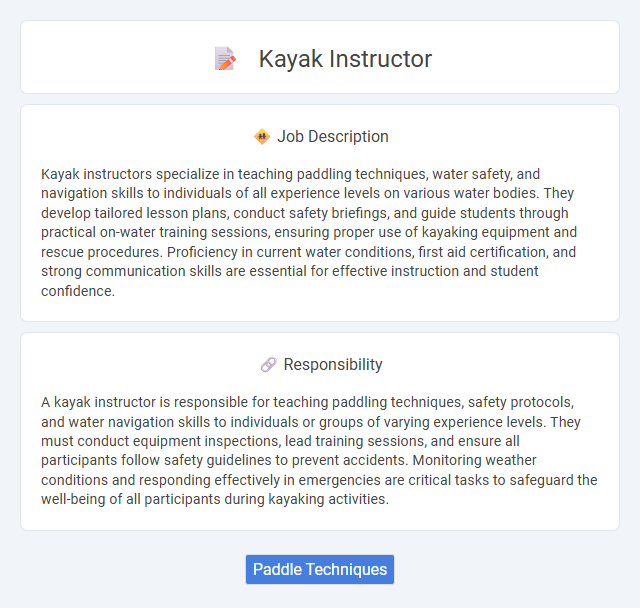
Kayak instructors specialize in teaching paddling techniques, water safety, and navigation skills to individuals of all experience levels on various water bodies. They develop tailored lesson plans, conduct safety briefings, and guide students through practical on-water training sessions, ensuring proper use of kayaking equipment and rescue procedures. Proficiency in current water conditions, first aid certification, and strong communication skills are essential for effective instruction and student confidence.
Individuals with strong swimming skills and physical endurance are likely suitable for a kayak instructor job due to the demands of guiding and assisting participants on water. People comfortable in outdoor, often unpredictable environments may find this role enjoyable and manageable. However, those prone to motion sickness or with limited upper body strength might face challenges in fulfilling the job requirements.
Qualification
Kayak instructors must possess strong paddling skills and comprehensive knowledge of water safety protocols to ensure a secure learning environment. Certifications from recognized organizations such as the American Canoe Association (ACA) or British Canoe Union (BCU) are often required, demonstrating proficiency in kayaking techniques and rescue procedures. Effective communication abilities and prior experience in outdoor education or water sports enhance an instructor's capability to teach diverse skill levels and manage group dynamics efficiently.
Responsibility
A kayak instructor is responsible for teaching paddling techniques, safety protocols, and water navigation skills to individuals or groups of varying experience levels. They must conduct equipment inspections, lead training sessions, and ensure all participants follow safety guidelines to prevent accidents. Monitoring weather conditions and responding effectively in emergencies are critical tasks to safeguard the well-being of all participants during kayaking activities.
Benefit
Working as a kayak instructor likely offers significant benefits such as improving physical fitness and enhancing outdoor skills. There is a strong probability of gaining valuable experience in leadership and safety management while guiding clients in diverse water environments. This role may also provide opportunities for personal growth and a deep connection with nature, contributing to overall well-being.
Challenge
A kayak instructor job likely presents considerable physical and environmental challenges, requiring strong adaptability to changing water conditions and weather. The role probably demands effective risk management skills to ensure safety during difficult maneuvers and unpredictable situations. Overcoming these challenges may result in enhanced leadership abilities and a deepened connection with nature.
Career Advancement
A kayak instructor career offers progressive opportunities through certifications such as ACA (American Canoe Association) levels, enhancing teaching skills and safety expertise. Developing advanced guiding and coaching abilities can lead to roles in outdoor education management or expedition leadership. Strong experience and networking within adventure sports communities significantly boost prospects for career advancement and higher earning potential.
Key Terms
Paddle Techniques
Kayak instructors specialize in teaching advanced paddle techniques such as the forward stroke, sweep stroke, and draw stroke to improve maneuverability and efficiency on the water. They emphasize proper hand placement, stroke power, and body rotation to enhance paddling speed and reduce fatigue. Mastery of these techniques ensures safety and skill development for students in various water conditions.
 kuljobs.com
kuljobs.com